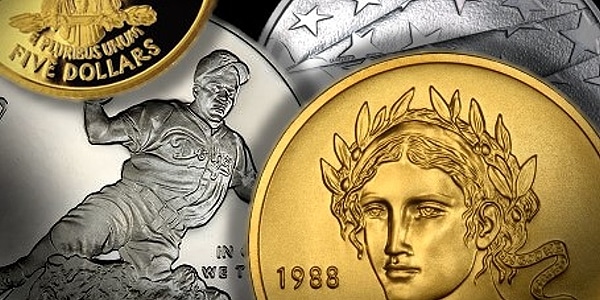
By Joshua McMorrow-Hernandez for PCGS ……
The year was 1982. Steven Spielberg’s E.T. The Extra-Terrestrial was soaring across the silver screen, the futuristic EPCOT (Experimental Prototype Community of Tomorrow) Center debuted at Walt Disney World in Florida, and Michael Jackson scored an iconic hit with “Thriller”.
 Meanwhile, the United States Mint struck its first commemorative coins since 1954 with the production of the George Washington half dollar commemorating the 250th anniversary of his birth in 1732.
Meanwhile, the United States Mint struck its first commemorative coins since 1954 with the production of the George Washington half dollar commemorating the 250th anniversary of his birth in 1732.
Not only did the 1982 George Washington Half Dollar mark the nation’s first official commemorative coinage in 28 years, but they were also 90% silver coins, the first produced by the U.S. Mint since 1964. Many collectors were absolutely enthralled to see these new commemoratives, with enough enthusiasm behind these special silver coins to push their cumulative proof and business-strike mintages beyond seven million pieces. It became one of the most successful commemorative coins in United States Mint history.
The sands of time were shifting with the winds of change. The year 1982 marked a transitional period for the United States Mint. Sweeping changes had recently brought the end of the unsuccessful 1970s-era Susan B. Anthony Dollar, the last circulating bronze Lincoln Cents, the arrival of a new Mint director Donna Pope, the installation of Elizabeth Jones as the Mint’s new chief engraver (and the first woman to hold that prestigious position), and stifling federal budget cuts that threatened hundreds of jobs at the mint and brought a two-year pause to the long-running United States Mint Uncirculated Set program. The birth of the modern commemorative coin program barely survived political infighting on Capitol Hill and fiscal belt-tightening under the newly inaugurated President Ronald Reagan.
Legislating a New Era in Coinage
The beginning of the modern commemorative coin era was hardly a capricious event landing at a random point in history. It was rather the culmination of a building series of numismatic and legislative events that can be easily traced back to the early 1970s. That was when United States lawmakers were engaged in an impassioned tussle with U.S. Treasury and U.S. Mint brass over proposals for coinage commemorating the United States Bicentennial, which marked the 200th anniversary of the signing of the Declaration of Independence.
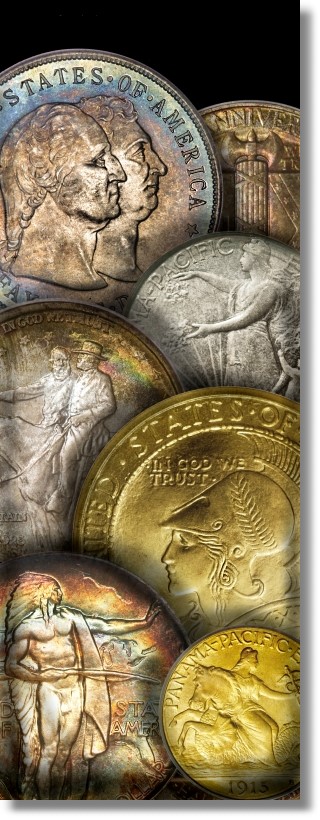 A few years after Congress chartered the American Revolution Bicentennial Commission in 1966 to begin planning for the gala extravaganza celebrating the nation’s 200th birthday, a Coins and Medal Advisory Committee was established within the commission in 1970 to explore minting a commemorative half dollar honoring the Bicentennial. Congress floated a series of Bicentennial coin proposals in 1971 and 1972, but none of these measures passed. They also drew stark criticism from U.S. Treasury officials and U.S. Mint Director Mary Brooks, who raised concerns that a new commemorative coin program could draw the same kind of financial abuses that plagued many of the commemorative coins issued in the 1930s, ‘40s, and ‘50s.
A few years after Congress chartered the American Revolution Bicentennial Commission in 1966 to begin planning for the gala extravaganza celebrating the nation’s 200th birthday, a Coins and Medal Advisory Committee was established within the commission in 1970 to explore minting a commemorative half dollar honoring the Bicentennial. Congress floated a series of Bicentennial coin proposals in 1971 and 1972, but none of these measures passed. They also drew stark criticism from U.S. Treasury officials and U.S. Mint Director Mary Brooks, who raised concerns that a new commemorative coin program could draw the same kind of financial abuses that plagued many of the commemorative coins issued in the 1930s, ‘40s, and ‘50s.
Further, as the Department of Treasury stated, there was concern that “multiplicity of designs on United States coins would tend to create confusion among the public, and to facilitate counterfeiting.” And, with some 21 different commemorative coins issued in 1936, the high-water mark for the classic commemorative series in terms of output, there was reason to be concerned about a glut of new commemoratives in the 1970s and beyond.
Fortunes soon began turning, with congressional compromises and concessions in the size and scope of a potential Bicentennial coinage program that gained the support of Mint Director Brooks and others instrumental in building the necessary groundswell of support to make Bicentennial coinage a reality. On October 18, 1973, an act that provided for “a new coinage design and date emblematic of the Bicentennial of the American Revolution for dollars, half dollars, and quarter dollars” was signed into law by President Gerald Ford. The massive success of the Bicentennial coin program in 1975 and 1976, which saw special patriotic redesigns of circulating clad and special 40% silver Washington Quarters, Kennedy Half Dollars, and Eisenhower Dollars, led many to believe that additional commemorative coin programs might also enjoy similar popularity.
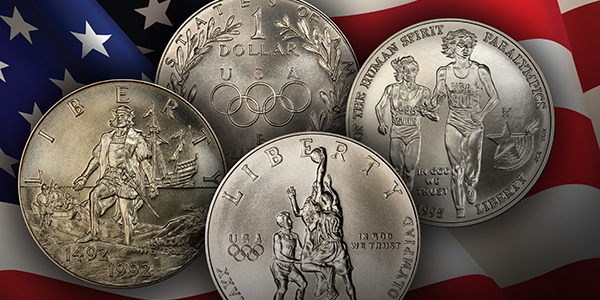 In 1981, Georgia Democratic Representative Druie Douglas Barnard, Jr., saw the upcoming 250th anniversary of George Washington’s birth more than warranting the issuance of a special commemorative coin. His bill proposed the minting of a 90% silver half dollar “emblematic of the two hundred and fiftieth anniversary of the birth of George Washington” and to be issued in 1982 “at a price equal to the cost of minting such half dollar coins (including labor, materials, dies, use of machinery, and overhead expenses).” Barnard’s bill worked its way through the halls of Congress throughout the spring of 1981, tweaks here and there as committees and subcommittees reviewed the bill.
In 1981, Georgia Democratic Representative Druie Douglas Barnard, Jr., saw the upcoming 250th anniversary of George Washington’s birth more than warranting the issuance of a special commemorative coin. His bill proposed the minting of a 90% silver half dollar “emblematic of the two hundred and fiftieth anniversary of the birth of George Washington” and to be issued in 1982 “at a price equal to the cost of minting such half dollar coins (including labor, materials, dies, use of machinery, and overhead expenses).” Barnard’s bill worked its way through the halls of Congress throughout the spring of 1981, tweaks here and there as committees and subcommittees reviewed the bill.
After various revisions and support from key figures such as Treasurer of the United States Angela “Bay” Buchanan, Deputy Director of the Bureau of the Mint Alan Goldman, and Chairman of the Subcommittee on Consumer Affairs and Coinage Frank Annunzio (a Democratic House Representative from Illinois), the bill passed the House with resounding support on May 19, 1981. Off to the Senate the proposal went, where it received positive nods from the Senate Committee on Banking and Congressional Budget Office. Passing the Senate on December 9, 1981, the bill authorizing the George Washington Commemorative Half Dollar was signed into law by President Ronald Reagan on December 23, 1981. A new day dawned in American numismatics.
Modern Commemoratives Take Root, Face Growing Pains
The first George Washington Half Dollars were struck at the Denver Mint on July 1, 1982, ushering in a new era for commemorative coins with a bang. Congress approved the production of up to 10 million of the George Washington halves; all told, a cumulative 7,104,502 Proofs and business strikes were sold, making the George Washington Half Dollar the most successful United States commemorative coin ever issued up to that point. Prospects were looking good for other commemoratives coming down the pike, including the various clad, silver, and gold pieces commemorating the 1984 Summer Olympics in Los Angeles and the upcoming 100th anniversary of the Statue of Liberty in New York City during 1986.
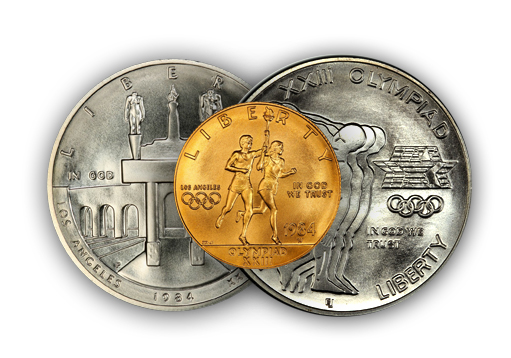
Notably, the Olympic coin program spawned the 1984-W Eagle, a gold coin with a face value of $10 that became the first United States coin to bear a “W” mint mark representing the West Point Mint and the first legal-tender gold coin produced by the United States Mint since 1933. Meanwhile, the 1986 Statue of Liberty commemoratives, inclusive of a Proof and business strike clad half dollar, silver dollar, and gold half eagle, inspired the sale of 15,491,169, with surcharges from the sale of the commemoratives benefitting the massive, multi-year Statue of Liberty restoration to the tune of $78 million.
With a trio of successful commemorative programs in collector cabinets by the end of 1986, the United States Mint seemed to have created a hit machine. An entire generation of collectors had been born and grown up without new United States commemorative coins minted during their lifetimes to that point, and they were finally getting to enjoy a fresh crop of new commemorative designs just as their parents and grandparents had decades earlier during the golden era of American commemoratives. A parade of new commemorative coins would carry the collectors into the 1990s and beyond, including coins honoring the bicentennials of the United States Constitution and United States Congress, the 500th anniversary of explorer Christopher Columbus’ arrival in the Americas, and the 50th anniversary of World War II.
But some collectors began feeling there may have been a little too much of a good thing, as more and more commemorative coins were beginning to enter the collectibles arena – perhaps at a clip that was becoming harder for some to keep up with. The monumental commemorative program released for the 1996 Summer Olympics in Atlanta was the straw that broke the camel’s back for many collectors. This massive 32-piece program involved 16 distinct designs in Proof and business-strike finishes encompassing four half dollars, eight silver dollars, and four $5 gold half eagles. The coins were offered individually, but those wanting the entire series found it far more cost effective to buy the entire kit and caboodle as a 32-piece set that, packaged in a locking wooden presentation case, was offered at a price of $2,261.
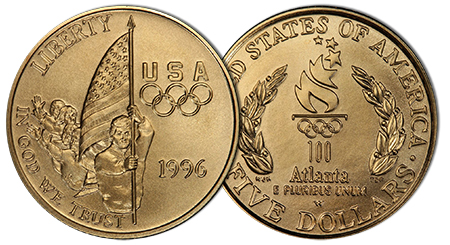 The ambitious 1995-96 Olympic commemorative program hit many collectors hard in the pocketbook at a time when several other commemoratives were also being released by the United States Mint, including coins paying homage to the Special Olympics, Civil War battlefield preservation, national community service, and the 150th anniversary of the Smithsonian Institution. What some might characterize as an oversaturation of commemorative offerings and increasingly heavy purchase prices dissuaded many collectors from pursuing any of the commemoratives in the mid-1990s, resulting in relatively low mintage figures for many pieces from that period, particularly a good deal of the 1995-96 Olympic commemoratives.
The ambitious 1995-96 Olympic commemorative program hit many collectors hard in the pocketbook at a time when several other commemoratives were also being released by the United States Mint, including coins paying homage to the Special Olympics, Civil War battlefield preservation, national community service, and the 150th anniversary of the Smithsonian Institution. What some might characterize as an oversaturation of commemorative offerings and increasingly heavy purchase prices dissuaded many collectors from pursuing any of the commemoratives in the mid-1990s, resulting in relatively low mintage figures for many pieces from that period, particularly a good deal of the 1995-96 Olympic commemoratives.
Concerns from some numismatists began echoing through the halls of Congress, where the Commemorative Coin Reform Act of 1996 was enacted and signed into law by President Bill Clinton to restrict the maximum number of commemorative coin programs issued in any given year to just two; the law took effect in 1998. Previously, as many as six different programs had been issued during the modern commemorative coin era, as was the case in 1994, and a whopping 10 commemorative issues had been released in 1995 and 1996. While that was a far cry from the nearly two dozen different commemorative programs keeping U.S. Mint employees quite busy in 1936, there was clearly a need for tighter parameters on commemorative coin production for the modern day.
Modern Commemoratives Come of Age, Break New Barriers
In terms of numismatic parlance, most collectors don’t generally categorize the 50 State Quarters program that launched in 1999 as a “commemorative coin” program in the traditional sense. Yet, it’s difficult to believe that the decade-long circulating 50-coin program honoring each state in the order they entered the Union could have ever happened if not for the overall positive reception of the modern commemorative coin program that debuted in 1982. The 50 State Quarters program became one of the most successful initiatives ever undertaken by the U.S. Mint, generating profits reaching into the billions and helping bring the number of American coin collectors to 140 million, according to United States Mint data from the mid-2000s.
 As other circulating commemorative design programs spun off in the years that followed, the U.S. Mint’s modern commemorative coin program continued trucking into the new millennium with gusto. In 2014, a major first was achieved for the U.S. Mint when it released its National Baseball Hall of Fame commemoratives, featuring curved planchets that showcased a concave catcher’s mitt obverse and convex baseball reverse, a common design marriage on the program’s clad half dollar, silver dollar, and gold half eagle. The 2018 Breast Cancer Awareness program offered what became the U.S. Mint’s first “pink” gold coin, apropos given the ubiquitous pink ribbon symbolizing support for breast cancer survivors. The theme of colorful breakthroughs continued into the 2020s, when the U.S. Mint kicked off the decade with the 2020 Naismith Memorial Basketball Hall of Fame commemoratives, the first United States coins to boast colorized features.
As other circulating commemorative design programs spun off in the years that followed, the U.S. Mint’s modern commemorative coin program continued trucking into the new millennium with gusto. In 2014, a major first was achieved for the U.S. Mint when it released its National Baseball Hall of Fame commemoratives, featuring curved planchets that showcased a concave catcher’s mitt obverse and convex baseball reverse, a common design marriage on the program’s clad half dollar, silver dollar, and gold half eagle. The 2018 Breast Cancer Awareness program offered what became the U.S. Mint’s first “pink” gold coin, apropos given the ubiquitous pink ribbon symbolizing support for breast cancer survivors. The theme of colorful breakthroughs continued into the 2020s, when the U.S. Mint kicked off the decade with the 2020 Naismith Memorial Basketball Hall of Fame commemoratives, the first United States coins to boast colorized features.
As the modern era of the United States commemorative coin ventures into its fifth decade of existence, collectors have an astounding diversity of coins to add to their collections. Topics range from civil rights leaders to outer space pioneers and virtually everything else this side of the Sun. The PCGS Set Registry provides collectors with numerous opportunities to build exciting sets of modern commemorative coins, including sets specifically geared toward uncirculated specimens, gold issues, Proof and Uncirculated strikes, and various other permutations.
What does the future hold for the United States modern commemorative coin program? The U.S. Mint has a broad array of commemorative coins lined up over the next several years, ensuring plenty of new material for collectors to pursue. Collectors will find that many modern commemoratives are obtainable at levels near or even below their original issue prices, making these coins particularly appealing to new collectors or those who were youths in the 1980s, 1990s, and 2000s and are coming into the fold today as numismatists. The 40th anniversary of the modern commemorative coin series therefore represents an ideal opportunity to start or expand upon a beautiful set of these unusual coins at attractive prices.
* * *





